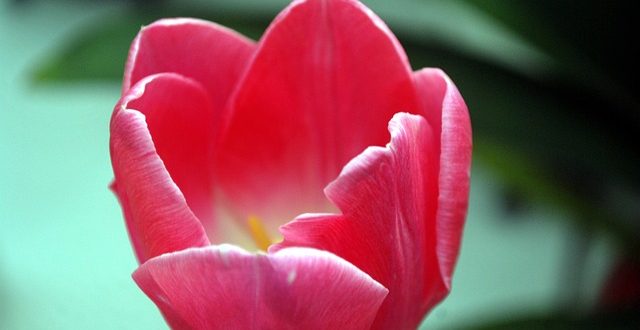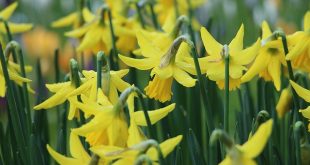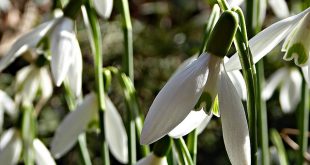By April, Spring has definitely arrived! From a faltering start, life in the garden is now clear to see and to enjoy. There is plenty to do but on those warm spring days, time to enjoy relaxing outside.
With longer hours of sunlight and increased heat to come, greenhouses need to have shading applied where appropriate and remember to check all automatic vents – it doesn’t take long to start cooking those delicate seedlings.
Spring Clean
Get ready to enjoy the warm days. Clean down garden furniture. Apply preservative to timber if necessary. Give the BBQ a good clean ready for the first suitable day. Pressure wash patios and decking if required. Make any repairs to supports, frames etc. before growth makes access more difficult. Check over renewing or installing ties in all parts of the garden.
Borders
Look away and a weed will appear! Hoeing a little but often will keep the weeds under control without ruling your life. Make sure that only the surface is disturbed, hoe too deep and you will bring up more weed seeds that otherwise would have remained dormant. This will be about the last chance to install a weed suppressant membrane this year. You can help the soil warm up quicker by using a cloche prior to sowing.
Apply compost both over the soil and around the plants, as well as adding beneficial organic matter it also helps to keep the annual weeds down which will start to become prevalent. Feed using a general fertiliser like blood, fish and bone if you have ran out of compost.
You can plant perennials and summer flowering bulbs. Sow hardy annuals outdoors. Sow half-hardy seeds in the greenhouse or indoors.
Many herbaceous plants will begin to show as the warmer weather comes in, so now is a good time to get frames over them to give support to both the foliage and flowers. No matter what the weather conditions, monsoon or drought, somehow weeds always manage to grow!
Deadhead any dying or dead daffodils to retain as much of the goodness in the bulb, instead of producing seed.
Vegetables
Sow your tomato seeds under glass. Prepare if you haven’t done already your vegetable bed, did in compost and cover with a cloche or black sheeting to warm it up. Check labels to see what to sow this month. Keep a look out for over-wintering aphids on young seedlings, but don’t reach for your trusty spray gun because seedlings in the early stages shouldn’t be sprayed with anything stronger than washing up liquid and water.
Fruit
You should protect fruit blossom from any late frosts with fleece. Mulch around fruit trees but avoid the trunks. Plant strawberries out.
Lawns
Damaged areas can be reseeded or turfed. Sow new lawns. As the weather permits, cut and box all cuttings from the lawn – start with the highest setting on the mower and gradually reduce the height over the next few weeks until you reach your desired cutting height for the season.
Aerate the entire lawn if you have the energy, or at least the poorer areas. Use a dedicated tool or a garden fork. For a showpiece lawn, learn from the professional greenkeepers. Topdressing assists in levelling and build the lawn up over time. It needs to be done when the grass is quite dry, only use a dedicated mixture.
At the end of the month consider the first application of weed, feed and moss killer. Remove any moss that raked out from the garden, do not compost it.
Roses
Roses are susceptible to mildew and aphid attacks. Spray with Nimrod-T. This is a combined application for pest and disease control. They will also benefit from an application of rose food such as Toprose. A small handful around each bush lightly forked in will ensure they receive many of the trace elements not found in quick release foods such as Growmore etc. A good organic concentrated food is 6X – it is derived from chicken manure and one whiff gives an indication of how powerful this stuff really is. A handful per sq. metre is all you need – use it on anything outside; even on the lawn and it won’t scorch.
Trees and Shrubs
Rhododendrons, Camellia and Pieris are flowering or about too. Make sure you apply some Sequestrene to ensure continued flowering with definitive colours. Use Sequesterene to adjust the pH in and around the soil of the plant. Sequested iron is a name for ‘chelated iron’. It comes in several forms, liquid, granules, or pellets from garden centres etc. Plants such as Rhododendrons, Camellia and Pieris (among others) require an acid soil to grow successfully. You can grow them in borderline acid/alkaline soil provided you apply Sequestrene at regular intervals. Aim to keep the immediate soil around the plant at a ph. of 6.5 or less. Typical signs of anaemia in the plant (when the soil becomes alkaline and locks up food to the plant) are a yellowing of the older leaves to begin with, followed by the new leaves in extreme cases. The liquid form will give quick results for plants that require it, whereas fork in the granules or pellets to retain optimum soil conditions for longer.
Pests
Warning – this time of year sees an influx in our dreaded garden enemies – slugs and snails. A recent survey conducted amongst the gardening public concerning pests & diseases amongst plants, found that surprise, surprise, slugs and snails were top of the list as garden pest number one.
With the continued milder winters now becoming the norm, they never seem to go away. Nematodes are becoming an increasingly popular method of control as more and more gardeners seek alternative methods to the traditional pellets – Nematodes are able to provide that in an organic and safe way! Some slugs are building up a resistance to metaldehyde, which is one of the active ingredients of many leading brand pellets. Nemaslug for example, used in conjunction with gravels and grits around plants, gives a more lasting effect, especially as Nemaslug is not effected by rain that the UK. With the emerging lush green shoots of herbaceous, Hostas and the like, do not delay, protect your precious plants now, before there is nothing left to protect.
Vine weevil will attack root systems. The larvae are legless grubs, creamy white in colour with brown heads. They attack the roots between autumn and spring. The adults however, will show damage as irregular holes in leaves during the growing season. They are non-selective as to which plants they attack. Address this problem with Nematodes.
Household Plants
April is also a good time to convince the forgotten houseplant, that you do love it really with a change of compost and a good clean of those otherwise very dusty leaves. Remember they breathe through those leaves in one form or another. Move up only one size in pot and cotton wool dipped in milk will suffice for wiping over the leaves.
 Gardeners Club The Gardeners Club is a free to join online club for everyone with an interest in gardening and gardens.
Gardeners Club The Gardeners Club is a free to join online club for everyone with an interest in gardening and gardens.





